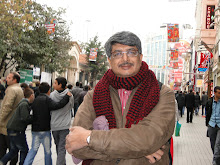We have a long history of collective celebration of various festivals. This formed the basis of social bonding and a way of expressing gratefulness to the elements. Every element of Nature was taken as a manifestation of the Divine.
Over the years one witnessed many changes. People’s perception changed, their preferences changed, they now had a different approach to religion and spirituality. A significant change in the last century has been the development of large urban agglomerations. Urbanisation, brought in its wake a different set of all-round changes.
Here, we will look at the positive spin-offs of collective celebrations of festivals. I had listed three, viz., Janmashtami, Ganpati and Navaratri celebrations which witness large and spontaneous celebrations.
I would begin by looking at some tangible benefits that have accrued to society
Keeping traditional arts alive due to patronage of these festive groups. Artisans from far and wide make their annual pilgrimage to these places and get value for their skills. Traditional arts are kept alive and more importantly these artisans absorb the latest and assimilate them in their working.
Judicious use of surplus financial resources to run many services as
- Education - Schools, Vocational training institutes,
- Health – Clinics, Ambulance services,
- Social – Aligning with civic authorities and NGOs for work on various issues like river cleaning in Pune, use of eco-friendly material, socially responsible celebrations, post-visarjan cleaning activities.
- Cultural activities covering art, music and sports
- Religious activities like bhajan groups, religion awareness classes.
- Charitable activities – assistance to school going children, shelters for the homeless,
I now turn my attention to some of the intangible benefits. These are important because many do not appreciate these at the first instance but play a very crucial role in our society.
• In today’s stressful times, involvement in organizing and managing is a great cathartic experience. Youthful energies are channeled into something constructive for almost two – three weeks before the actual festival and during the festival itself.
• Experts who have tracked this social phenomenon confirm an appreciable fall in levels of violence and stress. Mental problems also show significant regression.
• Religion is still a powerful motivating factor. Sending social messages intertwined with religion are an excellent way of attempting social change. Firstly, it spreads awareness and if there is a follow-up under a respectable banner, this can be used as a potent instrument of social reformation. One such group had successfully run a “Vyasana Mukti Abhiyan” (Programme to reduce / eliminate addictions) focusing on tobacco, pan masala and alcohol addictions.
• Involvement of local groups – A group festivity celebration puts the onus of good planning and execution on the organizers. This involves large groups of people in what is essentially voluntary work. This is a sort of forced team work and with a dash of devotion thrown in does a lot to promote social harmony. I have seen this especially, during Ganpati celebrations. Over the years, volunteers develop a sense of strong loyalty to group activity, and this becomes an annual pilgrimage of sorts.
• Participation by people in these festivals is an occasion for social interaction and bonding. It is also used by groups which move from one location to another for the “darshan”. In fact, there is a custom that one should see “Eleven Ganpatis”. This is a joyous group activity and increases the “feel good” factor in us.
• Beneficial vibes from participation in “Aarti” (ritual in which light either from lamps or camphor is offered to the deity) and “Bhajan” (collectively singing praises of God) sessions. It is widely accepted that collective prayer and singing has profound healing effects on the whole group.
I have listed some of the main positive spin-offs from our tradition of collective celebration of festivals. I am sure, if one were to study this subject in detail, it could form the basis of a doctoral thesis. I wonder if any one in India has chosen to study this.
It would be very illuminating to share experiences and view points from others – not only from India but across the whole wide world.







